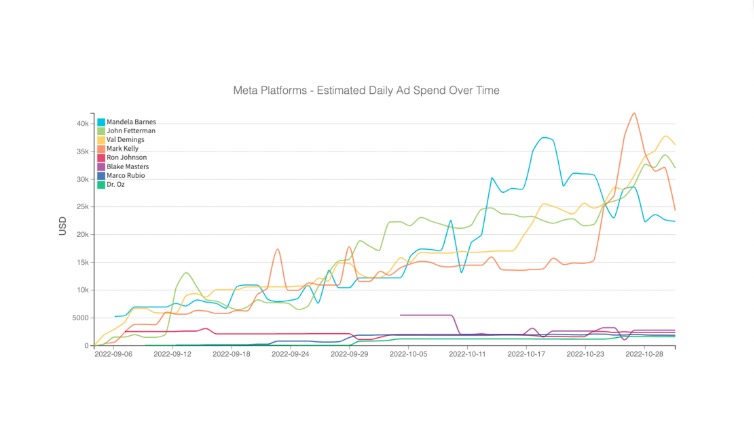By Danielle Spencer, Deputy Digital Director & Grace Turke-Martinez, Vice President and Analytics Director
January 18, 2023 – In our work in the 2022 midterm cycle, we noticed the striking differences between Democratic and Republican digital campaigns, as well as what marks some campaigns as truly exceptional. To demonstrate these findings, we took a closer look at four competitive Senate races — Arizona, Florida, Pennsylvania, and Wisconsin — all important races which were shaped by the unique political context in those states.
An excellent digital campaign can make a difference. It is just one factor that shapes the electoral outcome — along with candidate quality, money, incumbency, and the overall political climate — but it’s something a campaign can control. For voter persuasion and mobilization, the ability of digital ads (or any organizing tactic, for that matter) to move the needle may be marginal but still significant in tight contests. But online fundraising can make or break a campaign. A smart digital program is a critical component of any modern electoral campaign.
Throwing money at the problem isn’t enough to run a good digital campaign. Electoral digital campaigns have different needs from commercial campaigns. We have seen our clients, particularly in the international space, rely too heavily on marketing firms that don’t specialize in political work. You’re not just trying to drive site clicks or purchases; you’re trying to win votes and not turn others against you in the process.
In some ways, comparing Democratic and Republican campaigns is like comparing apples to oranges. They have different needs and different target audiences. Democrats need to fundraise more because they rely less on outside spending and dark money. Grassroots fundraising can indicate voter enthusiasm, but it’s also a necessity, the mother of invention.
Another difference is that the parties have different voter bases that engage differently on social media. According to a fact sheet from Pew Research Center, by February 2021, 72% of U.S. adults used at least one social media site. Women were more likely to use social media than men (78% vs. 66% using at least one site). Facebook was the most popular platform, with 69% of adults reporting use of this site. Women were more likely to report using Facebook than men (77% vs. 61%). Whereas some social media sites, like Instagram, Reddit, and TikTok, were used predominantly by younger users, Facebook usage was high among all age groups (in the 70 to 77% range for those aged 18 to 64, and 50% among those aged 65 or older). Use of YouTube was even higher than Facebook, with 81% of adults reporting they used it. YouTube use declined with age but was still high among all ages (between 83% and 95% for those under 65, and 49% among adults 65 or older).
The crux of a strong digital program, and something we know well from our work at TMG, is tailoring the right message to the right audience at the right time.
A mature digital campaign does a few things well: it starts early, fundraises, and, most importantly, tests various content and audiences. Some content tends to work well in general, like photos of people in the real world. Authenticity is another mark of good content and a strong candidate, broadly speaking, but that’s a difficult attribute to pin down. Other aspects of what may work well or fail spectacularly can be harder to predict, and that is why testing (which requires a lot of content) is so important.
We dug into the publicly available data from Meta and Google to see what we could glean about these campaigns. To determine success, we evaluated the timing of ad spending and whether campaigns tested a variety of content, differentiated their audience, and advertised across multiple platforms to reach voters in various places.
Advertising on Meta
One of the first things we noticed was the late start of a few Republican campaigns. Six of the eight candidates we looked at were live with general election ads on Meta before Labor Day. The exceptions were Dr. Oz, who launched his first ad on September 19th, and Blake Masters, who launched the latest on October 11th. Both candidates had lackluster digital campaigns in general, but they were also recovering from bruising primary races. Arizona’s primary occurred late in the cycle (Aug. 2), which left less runway for the Masters campaign to shift to the general election.
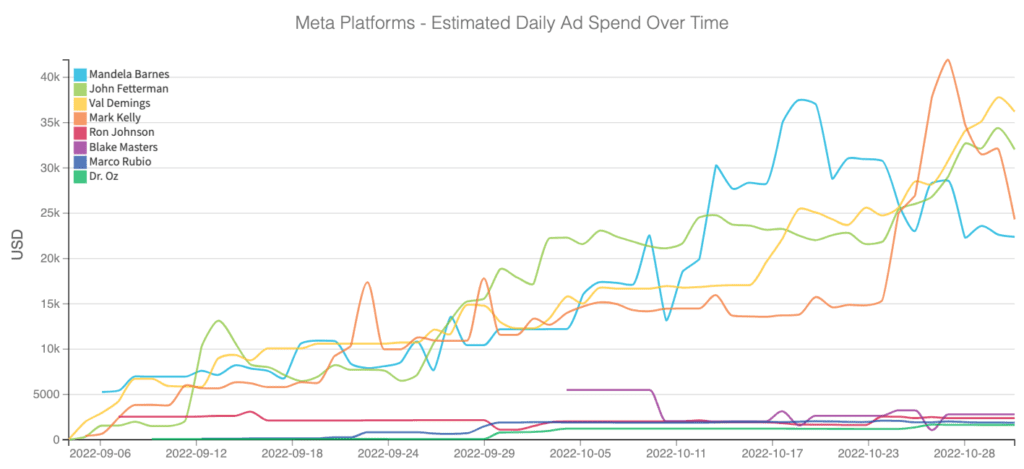
Larger digital campaigns had a major focus on fundraising, and these campaigns also spent significantly out-of-state. The Fetterman and Demings campaigns each dedicated around 70% of their sizable Meta ad spend toward fundraising appeals, and the Barnes and Kelly campaigns allocated around 50%. On the Republican side, the Johnson campaign used Meta ads almost exclusively for persuasion. The Peter Thiel-backed Masters campaign did no fundraising. These two campaigns also spent almost exclusively in-state, as their digital programs were limited to voter mobilization. In contrast, the Rubio and Dr. Oz campaigns used their Meta ads almost exclusively for fundraising and spent largely out-of-state.
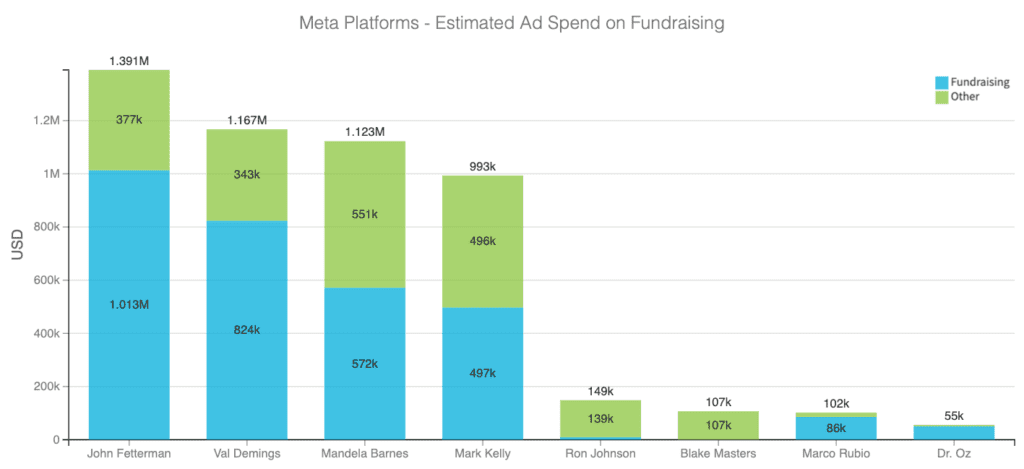
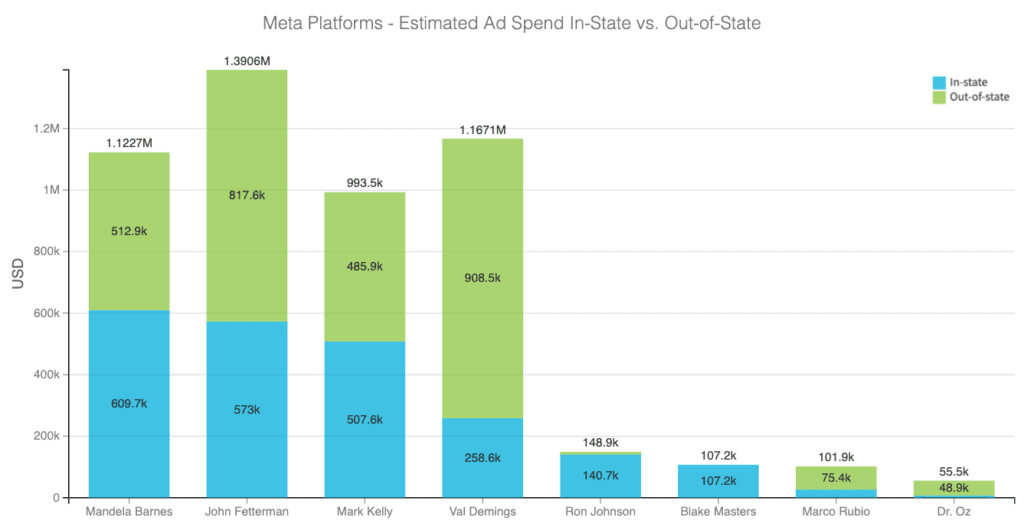
Sophisticated digital ad campaigns try a variety of ad content and audiences. The Fetterman campaign was the top spender among this group, but they also had by far the greatest number of ads, and nearly the lowest average spend per ad (around $500) on Meta. At the other extreme, the Masters campaign ran just 37 different ads (an average of $2,900 per ad). While the Rubio campaign had a relatively small digital ad presence, they spent in a targeted way and had the lowest average spend per ad (about $400).
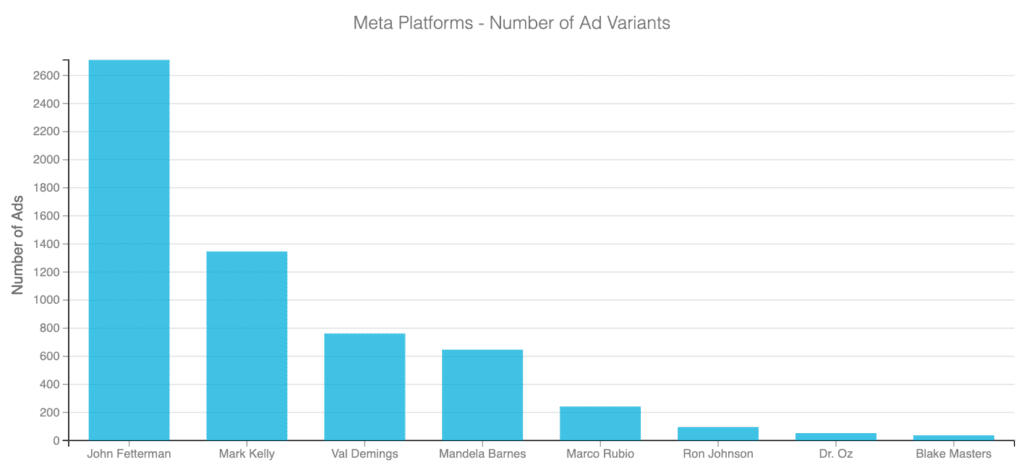
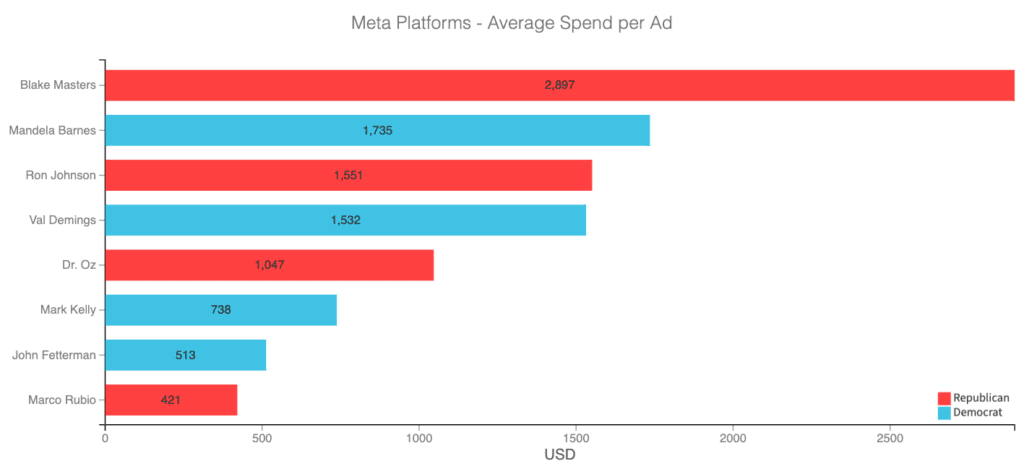
Sophisticated campaigns think strategically about their targeted audiences. They test how different ads work with diverse groups. For example, we often expect different messaging to work well with women 18-24 compared to men 65 and older. Campaigns should consider their key audiences for persuasion, turnout, and fundraising, as well as how they will engage with these groups across different media when designing digital ad campaigns.
We saw, not surprisingly, that all the Democratic campaigns dedicated 60% or more of their digital ad spending toward women. The Rubio and Oz campaigns dedicated 55% or more of their spending toward men. The Johnson and Masters campaigns split their spending almost evenly, suggesting they may have done little to no targeting.
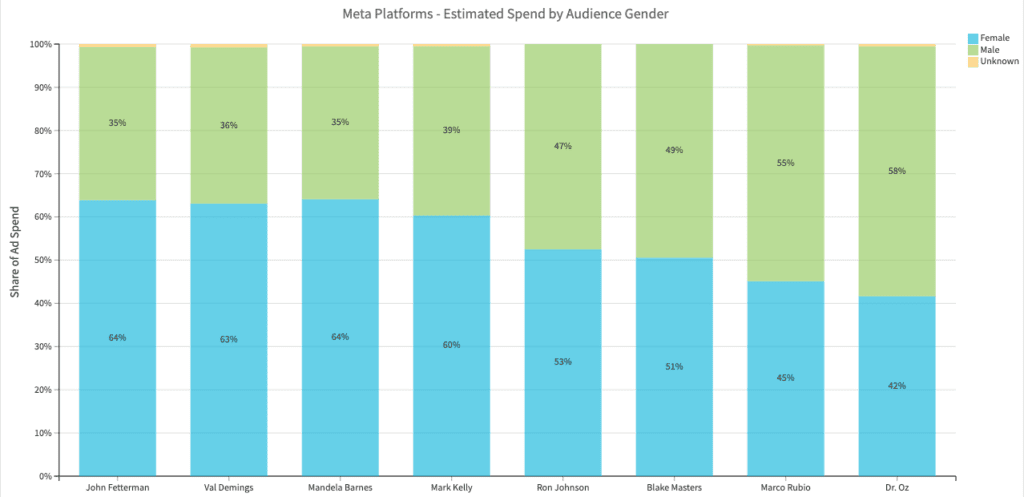
Similarly, when we considered spending by age, we saw Democratic campaigns spent between 45% and 75% of their digital ad spend targeting users 55 or older. The Rubio and Oz campaigns targeted nearly 80 to 90% of their Meta ad spend toward users 55 or older. The Johnson and Masters campaigns divided their ad spend nearly proportionally across age groups, again suggesting they may have done little to no targeting.
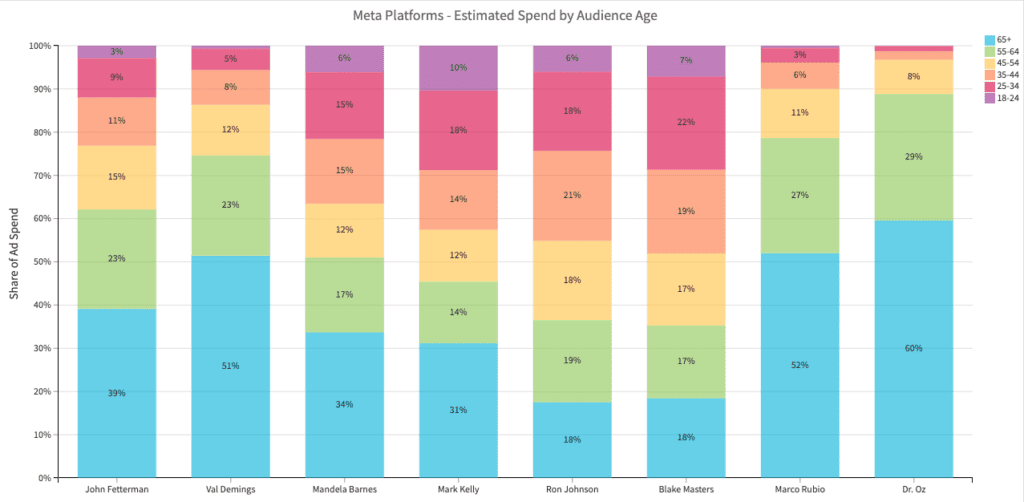
Advertising on Google
Another indicator of a robust digital campaign is being active on different platforms. We looked at transparency data from Google to see how candidates reached target voters beyond social media. Engaging on a variety of platforms increases the likelihood of reaching a broad audience since not all voters are active (or regularly active) on Meta platforms. The chart below shows the total spend for each candidate across YouTube, Google Search, and Google Display. For Val Demings and Marco Rubio, there were two different accounts separating spending on persuasion from fundraising. The figures below for their campaigns represent the persuasion channels of their campaigns. In addition to the spends represented in the chart, Val Demings spent $578,300, and Marco Rubio spent $161,500 on additional Google accounts focused on fundraising efforts.
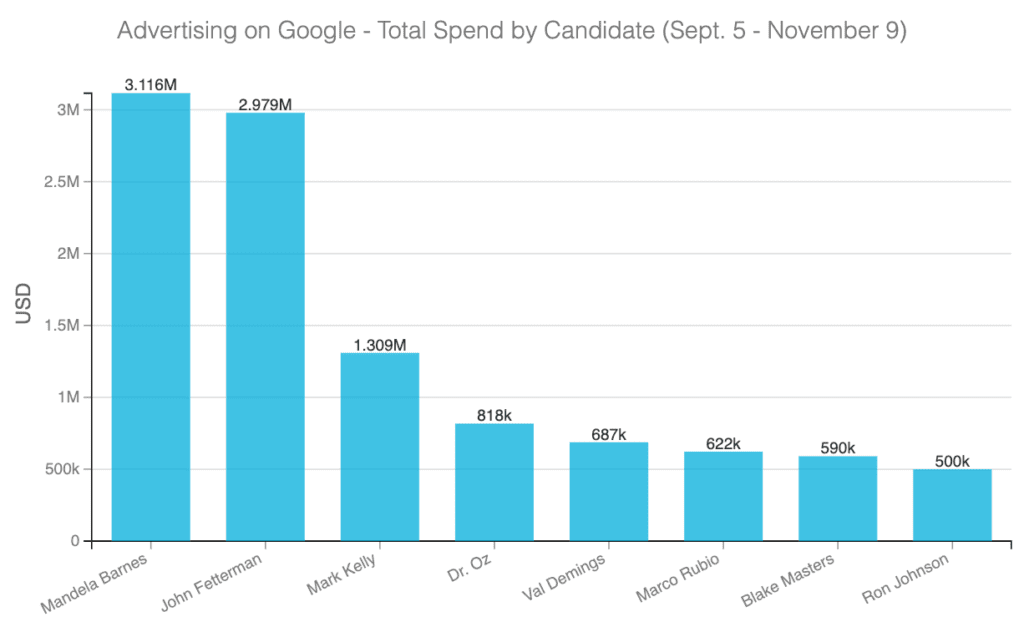
We found that Democratic candidates significantly outspent Republican candidates on Google. For example, John Fetterman spent almost four times more than his opponent Dr. Oz, even though Oz was the top spender on Google platforms among the Republican candidates we studied. There was a stark contrast between Mandela Barnes, who spent the most overall, and his opponent Ron Johnson spent the least among all the candidates analyzed. This contrast suggests that Democratic candidates were doing more to deploy more extensive digital campaigns and ensure they reached voters as often as possible leading up to Election Day.
We analyzed the number of ads each candidate ran as evidence of each digital campaign’s complexity. In most cases, the Democrats ran at least twice as many ads as their Republican opponents. Running a larger number of ads allowed Democratic candidates to test more content and ensure they delivered the right message to the right audience.
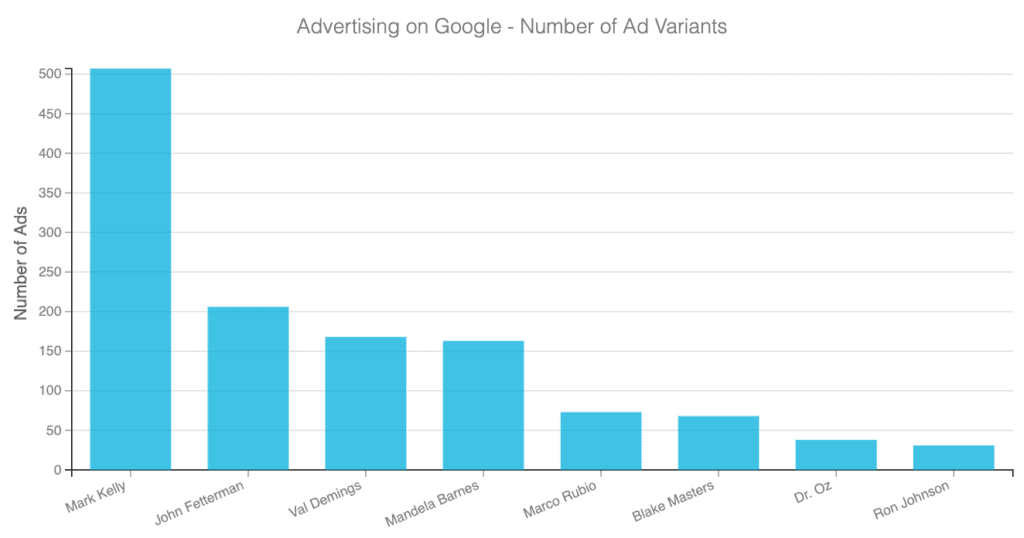
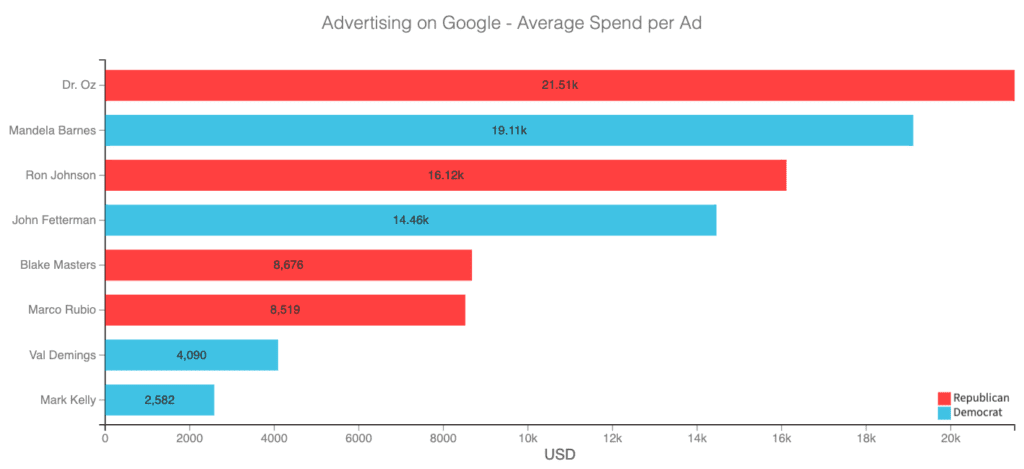
When we looked at how spending and the number of ads translated to a tactical execution across platforms, we saw that Republicans utilized more channels than Democrats. The chart below highlights the spending across YouTube, Google Search, and Google Display among the candidates we analyzed. Republican candidates were more likely to use all available channels. While it made up the smallest portion of their spending, candidates like Ron Johnson and Blake Masters were the only candidates to utilize Google Display advertising. Marco Rubio also used display advertising, but only on his Google Account dedicated towards fundraising.
Another notable difference between Democrats and Republicans was the prioritization of YouTube or video advertising versus Google Search. We found that Democratic candidates invested heavily in video advertising. The only exception to this trend was John Fetterman, who prioritized search over video advertising. This decision may have been a strategic response to the scrutiny he faced over health concerns and search’s ability to find users as they are actively looking for more information. Among Republicans, Marco Rubio was the only candidate to fully emphasize video advertising.
Overall, candidates tended to focus their budgets more heavily on one platform over another, with Republicans spending 54 to 88% of their Google resources to Search, and Democrats, except Fetterman, dedicating 69 to 95% of these resources to YouTube.
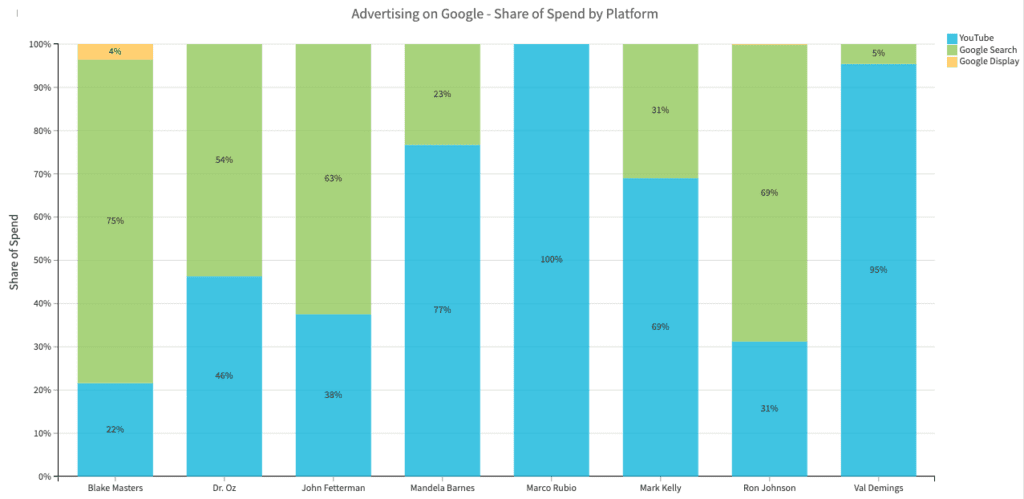
The Big Picture
Democrats did well overall. They consistently tried more varied content and targeted strategically. We want to recognize Mark Kelly’s campaign for its exceptional YouTube program; that campaign tested a wide variety of content on a smaller budget, allowing them to optimize their resources. We also want to highlight John Fetterman’s digital program as a cut above the rest. They excelled at testing a wide variety of content in a cost-effective way, and they approached things differently from the other Democratic campaigns. For example, they allocated money differently across Google advertising.
What can we learn from the Republicans?
They were active on more channels, especially Search. Google Search is a more expensive platform, but it may help you reach a higher-intent audience. This may be an area where Democratic digital campaigns want to invest more in 2024.
What was perplexing?
Only Republicans invested in Google Display, and even that was a small share of their digital ad budgets. Display has the potential to reach internet users beyond specific websites and to reinforce advertising shown on other media. This seems like a worthwhile channel Democrats are underutilizing.
Democrats relied heavily on video advertising compared to Republicans, who were more likely to reserve some budget for display ads when advertising on Google. We don’t know why. Maybe Democratic campaigners view display ads as ineffective (we don’t necessarily agree), or maybe these campaigns have sunk a lot of money into the production of TV ads, so they want to repurpose this material to get as much mileage as they can from those efforts. We encourage campaigns to reflect on their reasoning and consider adding static ads to the content mix.
We know that good programs start early, fundraise (if needed), take a nuanced approach to audience targeting, and try a variety of content and audiences. Learning from what Republicans have done well, we add to this: a strong paid digital program operates across various platforms to make sure they reach voters where they are.


